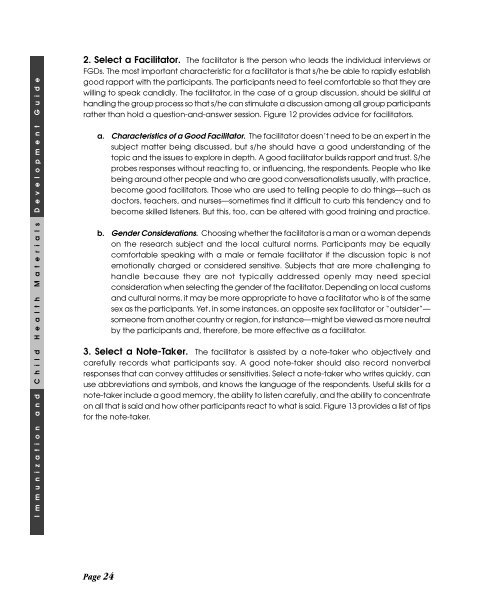Immunization and child health materials development guide pdf
Immunization and child health materials development guide pdf
Immunization and child health materials development guide pdf
You also want an ePaper? Increase the reach of your titles
YUMPU automatically turns print PDFs into web optimized ePapers that Google loves.
2. Select a Facilitator. The facilitator is the person who leads the individual interviews or<br />
FGDs. The most important characteristic for a facilitator is that s/he be able to rapidly establish<br />
good rapport with the participants. The participants need to feel comfortable so that they are<br />
willing to speak c<strong>and</strong>idly. The facilitator, in the case of a group discussion, should be skillful at<br />
h<strong>and</strong>ling the group process so that s/he can stimulate a discussion among all group participants<br />
rather than hold a question-<strong>and</strong>-answer session. Figure 12 provides advice for facilitators.<br />
a. Characteristics of a Good Facilitator. The facilitator doesn’t need to be an expert in the<br />
subject matter being discussed, but s/he should have a good underst<strong>and</strong>ing of the<br />
topic <strong>and</strong> the issues to explore in depth. A good facilitator builds rapport <strong>and</strong> trust. S/he<br />
probes responses without reacting to, or influencing, the respondents. People who like<br />
being around other people <strong>and</strong> who are good conversationalists usually, with practice,<br />
become good facilitators. Those who are used to telling people to do things—such as<br />
doctors, teachers, <strong>and</strong> nurses—sometimes find it difficult to curb this tendency <strong>and</strong> to<br />
become skilled listeners. But this, too, can be altered with good training <strong>and</strong> practice.<br />
b. Gender Considerations. Choosing whether the facilitator is a man or a woman depends<br />
on the research subject <strong>and</strong> the local cultural norms. Participants may be equally<br />
comfortable speaking with a male or female facilitator if the discussion topic is not<br />
emotionally charged or considered sensitive. Subjects that are more challenging to<br />
h<strong>and</strong>le because they are not typically addressed openly may need special<br />
consideration when selecting the gender of the facilitator. Depending on local customs<br />
<strong>and</strong> cultural norms, it may be more appropriate to have a facilitator who is of the same<br />
sex as the participants. Yet, in some instances, an opposite sex facilitator or “outsider”—<br />
someone from another country or region, for instance—might be viewed as more neutral<br />
by the participants <strong>and</strong>, therefore, be more effective as a facilitator.<br />
3. Select a Note-Taker. The facilitator is assisted by a note-taker who objectively <strong>and</strong><br />
carefully records what participants say. A good note-taker should also record nonverbal<br />
responses that can convey attitudes or sensitivities. Select a note-taker who writes quickly, can<br />
use abbreviations <strong>and</strong> symbols, <strong>and</strong> knows the language of the respondents. Useful skills for a<br />
note-taker include a good memory, the ability to listen carefully, <strong>and</strong> the ability to concentrate<br />
on all that is said <strong>and</strong> how other participants react to what is said. Figure 13 provides a list of tips<br />
for the note-taker.<br />
Page 24

















